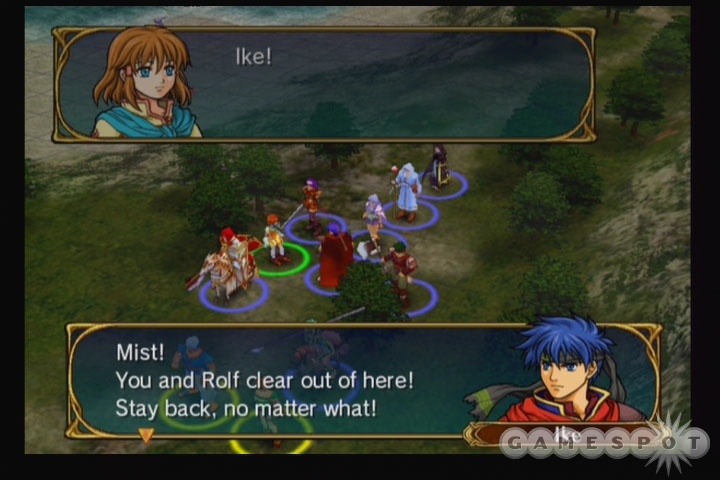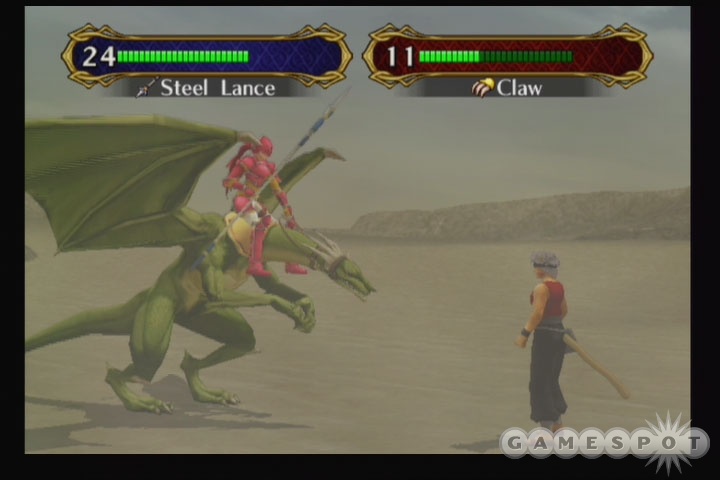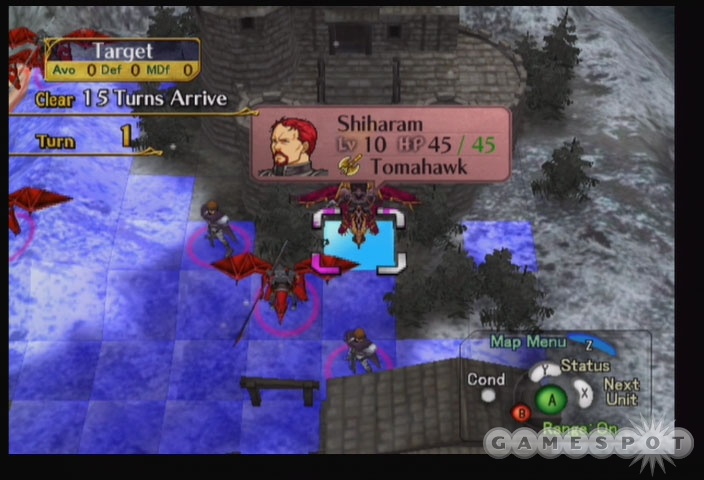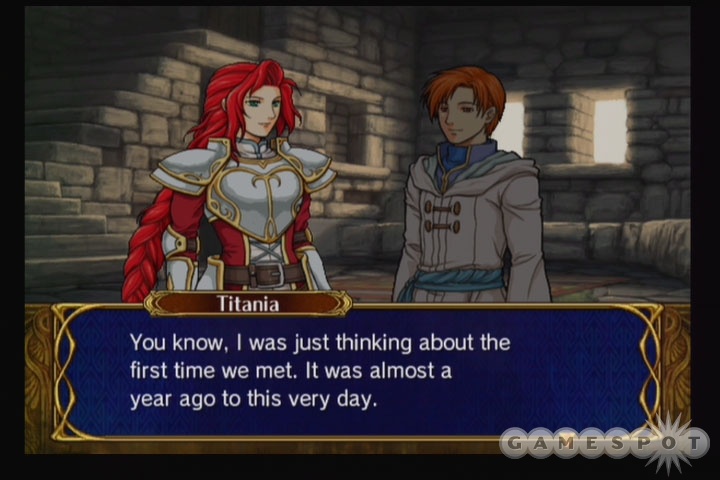Much like how the unassuming young hero of Fire Emblem: Path of Radiance eventually rises up to face incredible odds, so does this strategy role-playing game turn out to be a resounding success despite a plain-looking presentation. Those who've played the Fire Emblem games for the Game Boy Advance will find that, above all, Fire Emblem for the GameCube doesn't mess with the series' successful formula and signature touches. That means you can look forward to a long series of challenging turn-based battles, a gripping storyline that takes the time to develop a huge cast of great characters, and the feeling that the decisions you make in combat carry life-or-death consequences for your squad. Fire Emblem: Path of Radiance probably could have taken a few more risks with its design, and its 3D graphics ironically lose some of the personality found in the GBA games. However, these are minor setbacks for what is by all means an incredible, epic journey well worth experiencing by Fire Emblem fans or by anyone who likes role-playing games.

At the center of Fire Emblem's storyline is an aspiring warrior named Ike, son of an experienced mercenary commander and the heir to his father's dangerous business. The Greil Mercenaries initially seem content to take on odd jobs to earn a living and clean up the countryside. But when the neighboring country of Daein suddenly mounts an all-out attack against the Crimean capital city, the Greil Mercenaries must decide where to place their allegiance. Ike finds himself in a leadership position earlier than he anticipated, and as his mercenary company threatens to break apart amid the turmoil, he finds himself heading toward the country of Gallia for refuge. But Gallia is the land of the laguz, a race of werewolf-like demihumans capable of transforming into savage beasts. Tensions between the laguz and the rest of society run high, and soon Ike finds himself caught in the middle of two significant conflicts: Daein's imperialistic endeavor to conquer the continent, and a deep-rooted animosity between his people and the laguz. During the course of the adventure, Ike and his mercenary company become central to the future of their world, and they take to this responsibility in many different ways.
The story in Fire Emblem: Path of Radiance unfolds mostly through onscreen text and lightly animated portraits in between and during battles, though some nicely done cinematic cutscenes are included to accentuate key moments. This is the same exact technique as what's used by previous Fire Emblem games, so now that the series is on the GameCube, the simple presentation and abundance of written dialogue may be initially off-putting. However, the storytelling in this Fire Emblem is as good as ever, and the story is really what ties the whole experience together and soon makes you anxious to help Ike and his companions fight for their every victory (even some of the bad guys are sympathetic). It's easy to get wrapped up in all the details of the game after only a few hours, as there's so much background and history to absorb and the dialogue is so well written. Through it all, the story keeps you guessing, touches on some of the same serious themes as the previous games, and somehow avoids becoming overly convoluted.
Fire Emblem: Path of Radiance consists of a linear sequence of chapters, and you must successfully complete the battle in each chapter in order to move on. But the many optional characters and conversations that you'll encounter along the way, not to mention the fact that your characters' lives are in your hands, help make you feel like an active participant in the events, rather than a spectator. Strip away the storyline and you're left with a well-designed, turn-based tactical combat game, which does a great job of simulating the lethality of battle. It typically doesn't take more than a couple of hits from a sword, axe, or spear for a character to be killed. And if that character happens to be a member of your squad, then he or she is gone forever. Fire Emblem takes place in a fantasy world, but there are no convenient resurrection spells here--death is a frightening reality. The game ends if Ike dies, but the story goes on if pretty much any other comrade of his falls in battle. You can always reset and restart the mission from scratch if you want to avoid any casualties, but some of the later battles are difficult, so sacrifices may need to be made in the name of progress. Fire Emblem's character death system has always been one of the series' distinguishing features, and it's every bit as punishing and compelling this time around.

The gameplay on the battlefield is virtually identical to the GBA Fire Emblem games, though fans will notice some minor additions, such as Ike's ability to give computer-controlled partner units basic orders, and how you may equip characters with certain special skills that give them unique advantages in battle. Thankfully all the character art is hand-drawn, and the isometric, fully 3D battles are the relative low point of the game's presentation. The graphics don't look like much, but at least it's easy to distinguish between your different units at a glance. You can typically bring about a dozen unique units into battle, and you may move them in any order during your turn. After your turn, the enemy may move all its forces until either you win or you lose. Many missions require you to wipe out all your enemies, but sometimes you'll need to reach a certain location, defend your position for a certain number of turns, defeat a particular target, and more.
The odds of each battle tend to be less than favorable, and the computer-controlled opposition won't hesitate to target your most vulnerable forces and generally give you a good fight. When one unit attacks another, the game cuts to a close-up as the two units exchange blows and damage is dealt. You may toggle off these sequences if you want the gameplay to move along faster, which is useful for when you're replaying a tough mission or have simply grown weary of watching the same animations over and over. The combat animations mimic the same look and feel of the great-looking battles in the GBA Fire Emblem games, but they lose some of the series' distinctive visual style in translation to 3D. Fortunately, critical hits still look as deadly as ever, and some character classes like wyvern riders and paladins do look great. On the other hand, we were disappointed by how measly the knights, and especially the generals, in the game look by comparison to their 2D counterparts. However, the visual presentation in this Fire Emblem is clean and attractive on the whole.

As in previous games, you have to pay careful attention to the rock-paper-scissors relationship between the types of weapons commonly found on the battlefield. To oversimplify: swords beat axes, axes beat spears, and spears beat swords. There's a similar relationship between the different magic types, and a high-level fighter can still make short work of an opponent armed with an advantageous weapon. So the lack of too many hard-and-fast rules of engagement is really to Fire Emblem's advantage, since it turns out there really are many ways to accomplish each mission. You'll end up having many more characters on your side than you can bring to bear in a given battle (provided you don't let them die in droves), so deciding who to bring into the fray becomes a key part of the strategy.
In Fire Emblem, characters earn experience points mainly by participating in battle. So the best way to make one of your characters stronger is to make him or her fight. It's tempting to make your strongest warriors do all the heavy lifting, but the less experienced members of your squad need to learn, too. This has always been another of the series' interesting elements of play, but for better or worse, it's been mitigated somewhat in Path of Radiance. That's because you now earn bonus experience points, which may be freely distributed among your team back at base in between battles. The good news is this means you can bring the runt in the litter up to the relative level of your strongest fighters without putting in any real effort. The bad news is...the same thing. Dumping experience points on characters who've been sitting on the sidelines feels almost like cheating. And besides, you'll probably be more inclined to use those points to make your favorite characters stronger, rather than bring everyone up to the same standing. Still, this system does open up the gameplay a little, letting you make once-weak characters viable replacements to fallen friends.
The shape-shifting laguz also represent a new element on the battlefield. These powerful characters cannot attack in humanoid form, but they automatically transform into animal form, at which time they can wreak havoc before they turn back to humanoid form after awhile. They're an interesting, new type of combatant for Fire Emblem fans to consider who will otherwise be very familiar with the game's fighters, mages, priests, Pegasus knights, and so on. Characters now automatically upgrade to a stronger class when they reach a high-enough level, though you no longer get to choose between two classes as in the last Fire Emblem game. There are some other important nuances to consider, such as how mounted units may now effectively hit-and-run by getting to complete the remainder of their move after they attack, or how some characters may use their turn to push their friends or foes into an adjacent space. Most of the tweaks or additions in this Fire Emblem are welcome changes, but one admittedly minor detail that we were dismayed to see missing was the ability to read a brief biography of each character (including enemy captains). These one- or two-sentence descriptions did a lot to give the characters from previous Fire Emblem games more depth and personality. But here, you'll just have to infer who everyone is from how they look and what they say.

As mentioned, what Fire Emblem: Path of Radiance lacks in fancy 3D graphics it makes up for, at least in part, with a clean presentation and some good-looking 2D artwork. Fire Emblem's generic-looking anime art style (and preponderance of text) may not be particularly enticing to new players. However, it's once again put to good use here due to the game's huge cast of expressively drawn characters, whose faces animate slightly during dialogue. It would have been nice if all your characters' portraits changed when they changed classes, but it's a forgivable absence since there's just so much character art in the game.
Fire Emblem's few cinematic cutscenes feature spoken dialogue that's delivered quite well. The audio consists of an outstanding musical score and fitting hack-and-slash effects during battle. The music is orchestral and epic, stirring in tempo with how the battle and the story unfolds, and its synthesized instrumentation recalls the glory days of 16-bit role-playing games without sounding dated or cheesy. And just when you start getting a little tired of hearing the same combat themes over and over, the music changes up on you and becomes even better. Also of note, the game supports progressive scan displays as well as Dolby Pro Logic II-enabled sound systems, and if you've got either of the GBA Fire Emblem games, you can use a link cable to unlock some extras once you've finished the main quest.
Fire Emblem: Path of Radiance is perfect for fans of the GBA games, who'll find in this latest installment a long adventure that's every bit as good and as complex as that of the previous games. Path of Radiance is a fine place to start if you're new to the series, too, since the storyline is completely self-contained and the game mechanics are helpfully explained as you go. So don't be discouraged by the plain-Jane looks if you've never given this series a shot before. After all, by replacing the traditional random battles that typify most Japanese role-playing games with a fun and exciting turn-based combat system, and by going out of its way to deliver a memorable and genuinely emotional story, Fire Emblem: Path of Radiance accomplishes what all role-playing games attempt, but very few actually manage to do.